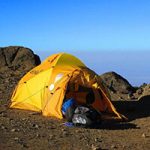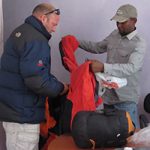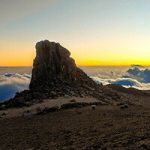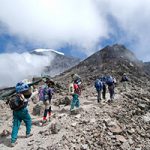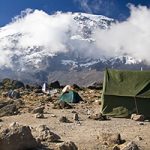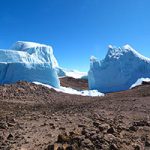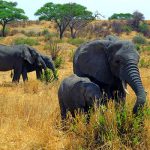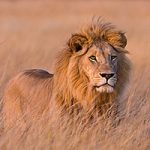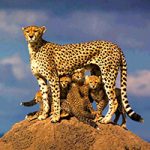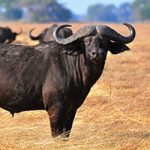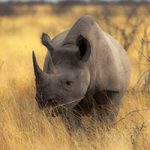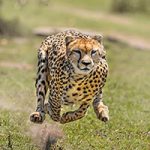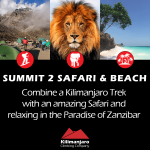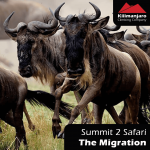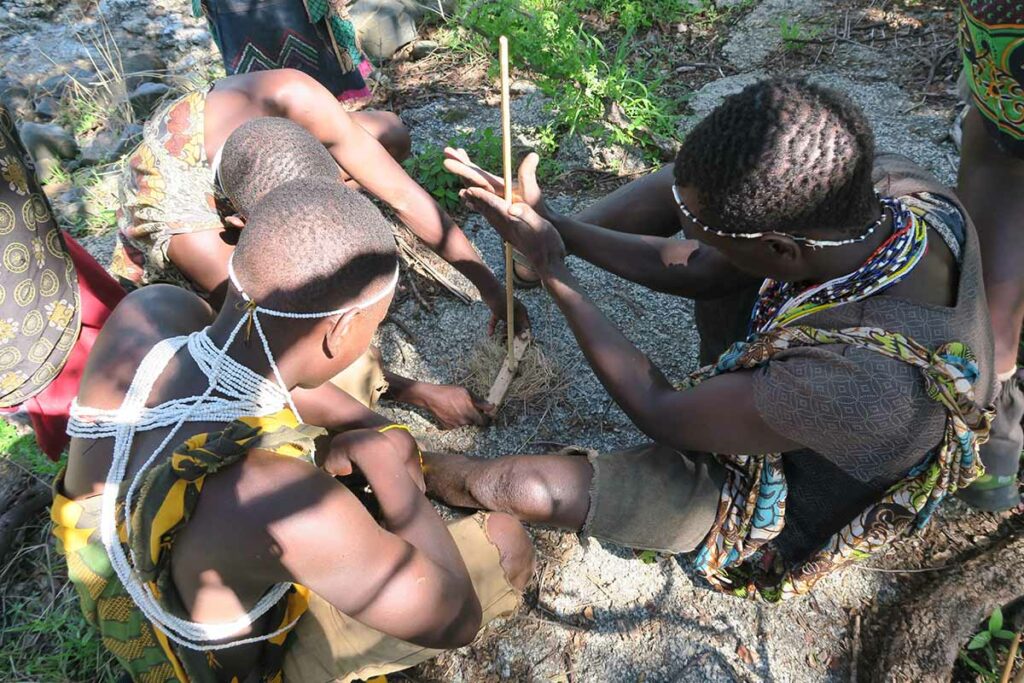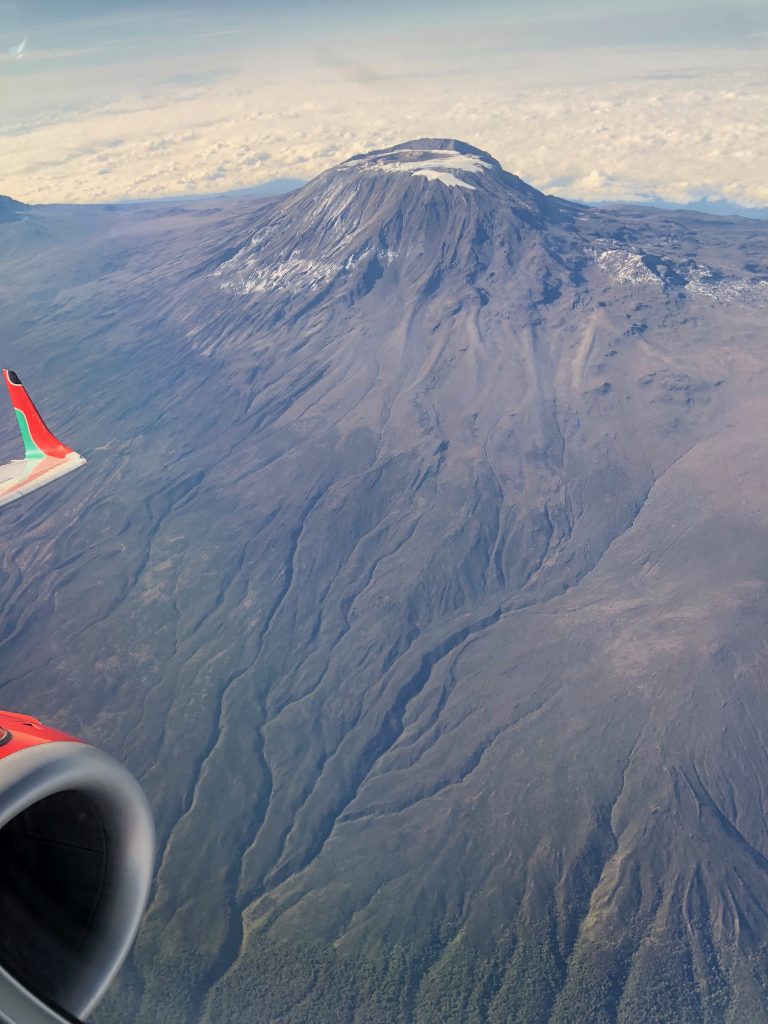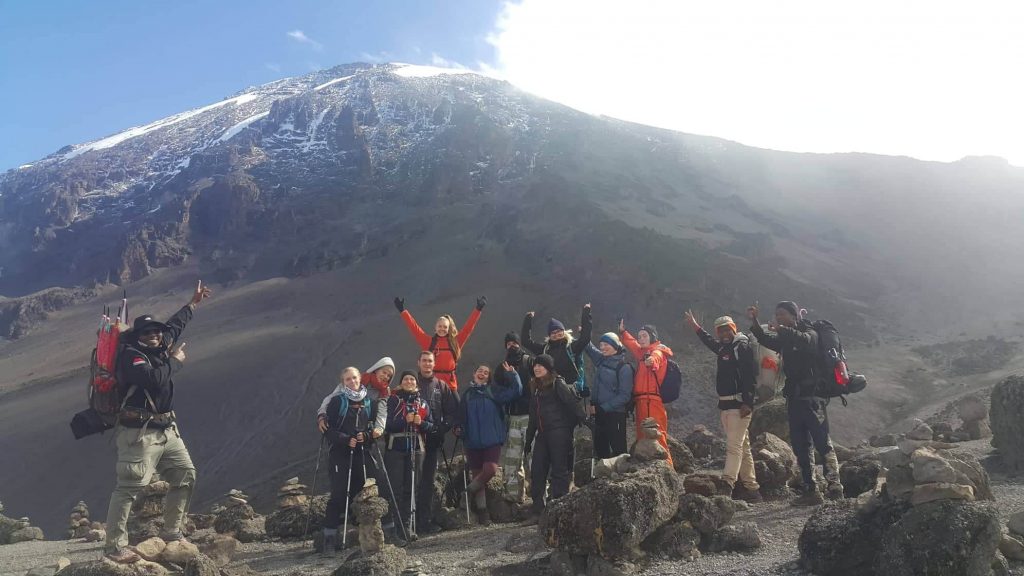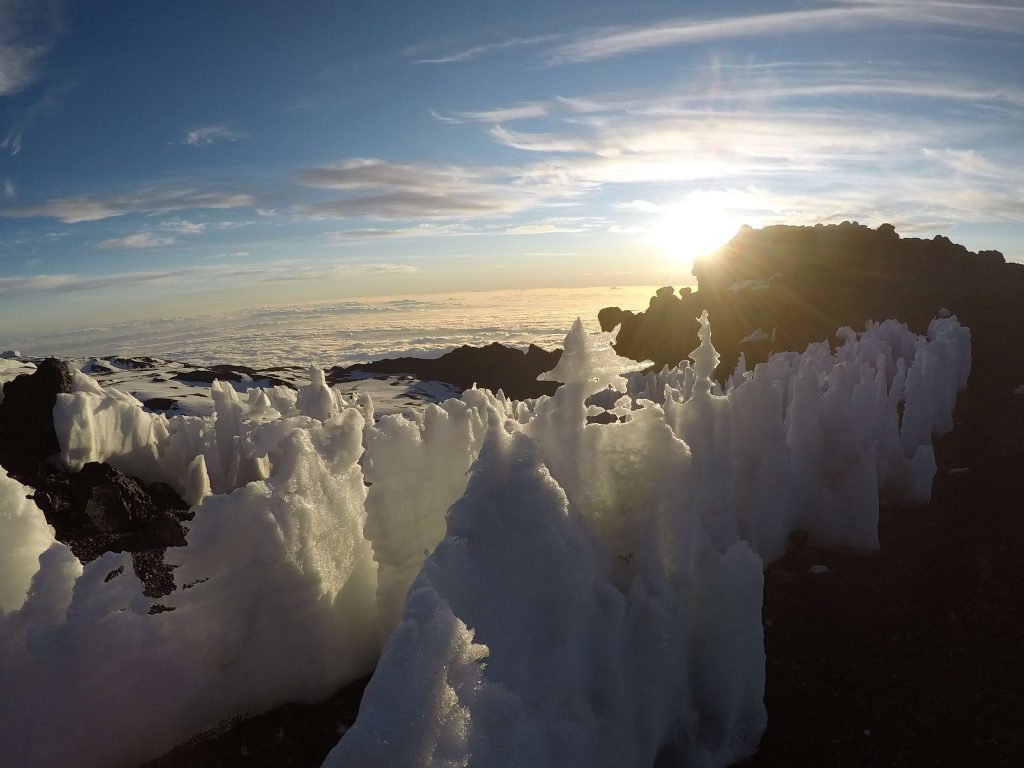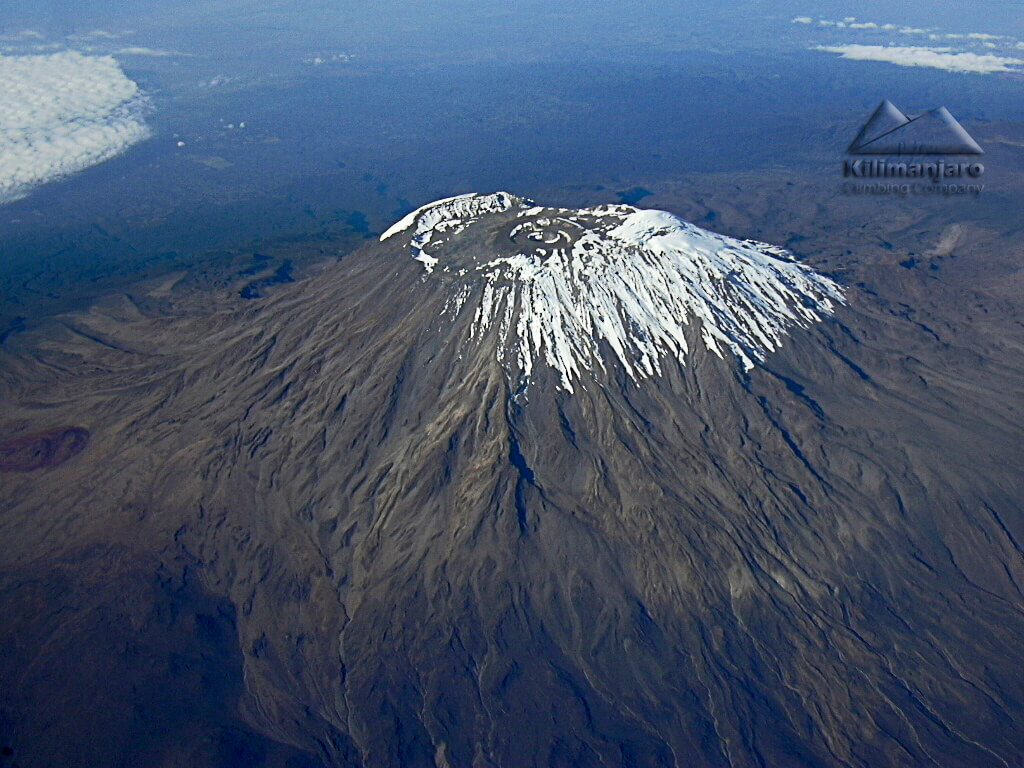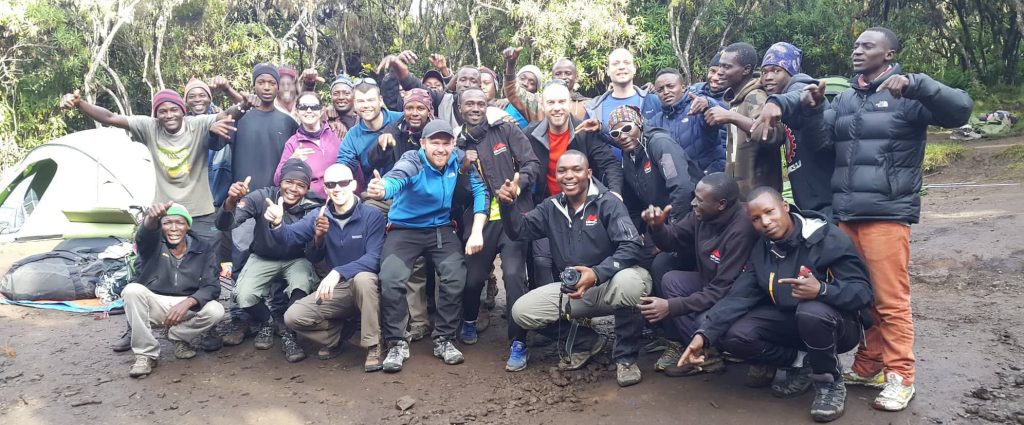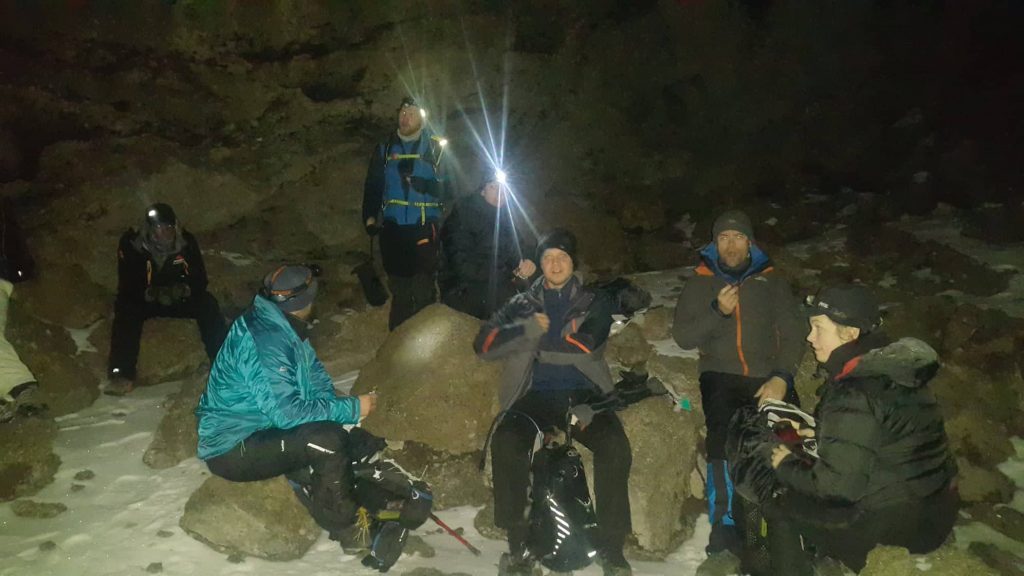1. Where is Kilimanjaro?
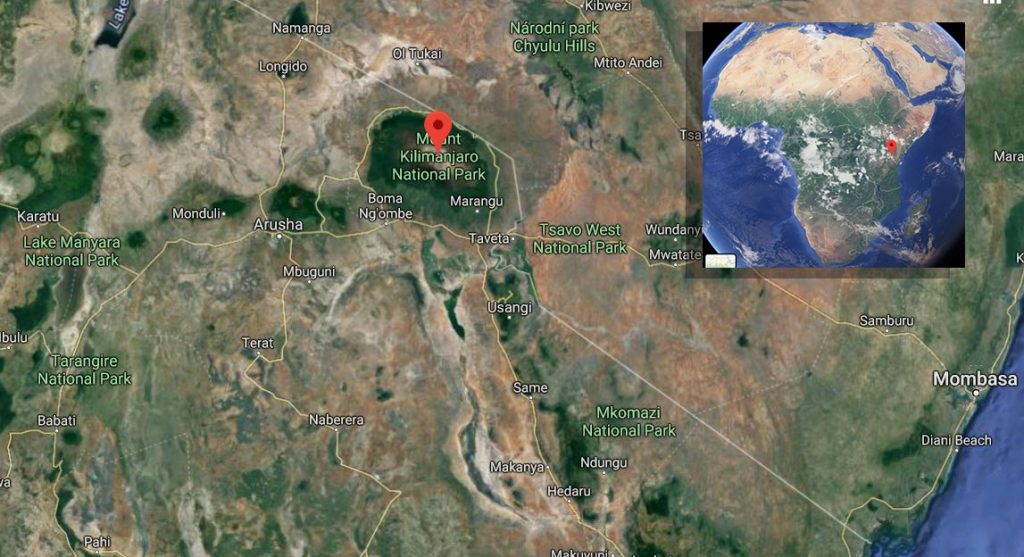

Although many people think Kenya when they hear Mount Kilimanjaro it is actually located in Tanzania. The mountain sits in Kilimanjaro National Park which is situated north of the city of Moshi in the north-eastern part of the country.
Kilimanjaro is 5,895 AMSL, making it Africa’s highest mountain. It is also the world’s highest free-standing mountain.
2. How do I get there?
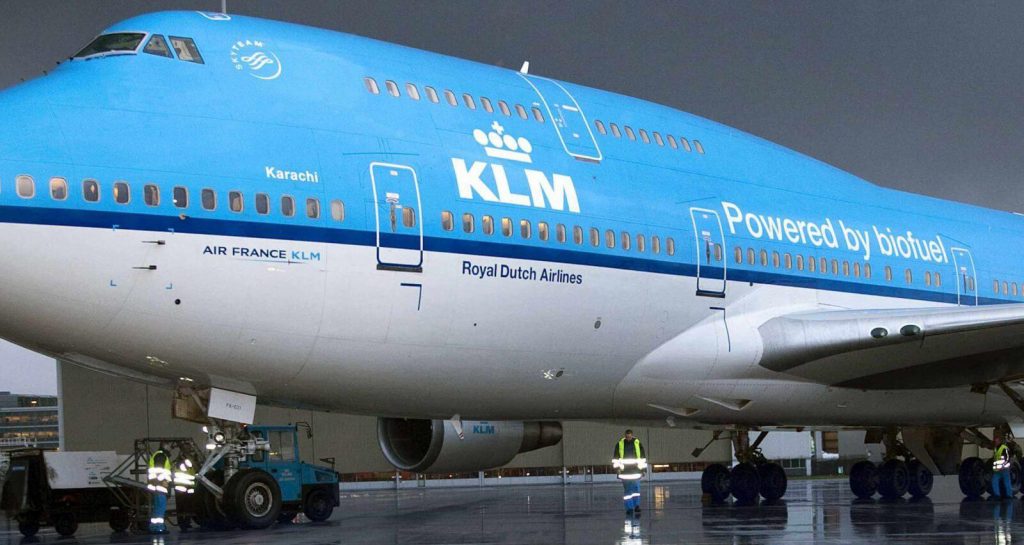
To get to Kilimajaro you need to fly into Kilimanjaro International Airport ( IATA code- JRO). It is possible to fly into Arusha airport, but this is a small domestic airport that only receives internal flights and a few connecting flights from Kenya
KLM
The most affordable, yet convenient flight for most prospective trekkers from the Northern Hemisphere is to fly from Amsterdam on a direct KLM flight to Kilimanjaro. Flights depart Amsterdam everyday and arrive at Kilimanjaro International Airport the same day. KLM often run deals on this flight, which can be – accessed here.. For trekkers in Europe, UK and the US, the easiest thing to do is to fly from a major local airport hub near you to Amsterdam (most major airports in Europe, UK and the US have flights to Amsterdam), and then catch the KLM to JRO connecting flight. KLM are very efficient and have a an excellent luggage allowance policy.
Kenyan Airways and Ethiopian Airways
It is possible to find cheaper indirect flights to major African airport hubs near Kilimanjaro International Airport with either Kenyan Airways or Ethiopian Airways. Both operate routes from major United Kingdom, United States, European and some Southern Hemisphere airports. These flights go via Nairobi (in Kenya) and Addis Ababa (in Ethiopia) respectively. Connecting flights to Kilimanjaro International Airport are relatively easy to catch with Kenyan Airways, Precision Air and Ethiopian Airways. A major downside of this route are the long delays and more worryingly, frequent reports of lost or delayed baggage, which can really mess up a trekking schedule.
British Airways
British Airways operate a route from London, UK to Nairobi, but this flight tends to be quite expensive
From Southern Africa
From Southern Africa there are many airlines that will get you to Nairobi, Dar es Salaam or Addis Ababa including South African Airways, Kenyan Airways and Emirates.
Qatar
A new international route direct to Kilimanjaro International Airport is operated by Qatar via Doha. For Brits living near London or Manches- ter this can work pretty well as there is an option of travelling from both UK airports to Doha. The route also works well for trekkers living in the Middle East, India and Eastern Europe. Unfortunately layovers can be quite lengthy.
Turkish Airlines
Turkish Airlines are the newest operator with direct flights to Kilimanjaro. Flights are via Istanbul. The flight times however, are ratheranti-social, with the flight arriving at Kilimanjaro at 02:00am and departing, if you are taking the same airline back at 03:00am! Prices tend to be cheaper than other airlines though, so this option may be worth considering if you are on a tight budget. However, with an arrival at 02:00am, any gains in a cheaper flight will most likely be lost in the cost of an extra hotel night that will be required unless you want to tackle Kilimanjaro jet-lagged and sleep deprived (not recommended!!). This route doesn’t run every day.
3. Do I need a visa?


Visa for Tanzania
To gain entry into Tanzania, most nationalities require a visa. Make sure that you have two free pages in your passport and 6 months validity on your return date.
Visa Applications
Although we have not had any problems obtaining a visa upon arrival, the Tanzanian High Commission advises visitors to apply for this in advance as they reserve the right to deny you a visa on arrival.
Visa on arrival
Obtaining your visa upon arrival is a relatively simple process. On entering Kilimanjaro International Airport (JRO) you will see two lines. The line on the right is for people applying for visas and the line straight ahead is for people who already have a visa. If you are applying for a visa you will be asked to fill out a form, show your passport and pay the relevant fee in US dollars.
All European & American citizens need a visa which you can apply for prior to departure or upon arrival. The cost for European and Canadian citizens is $50 and for $100 for US citizens. Those of other nationalities are advised to have USD 100 in cash ready, though in most cases the cost will be only USD 50.
Arriving and leaving from Kenya
If you arriving in to Nairobi instead of JRO you’ll need to take the Riverside Shuttle bus from Nairobi to Arusha. Passing through Kenya in this way you’ll require a Kenyan tourist visa which can be purchased at the airport when you land. A tourist visa for travelling to Kenya from Tanzania if opting to fly out from Nairobi, can be purchased at the Namanga border which you are required to cross, however if you entered Tanzania from Kenya on your way to Kilimanjaro then your original Kenyan visa will probably still be valid as nowadays Kenyan tourist visas are issued on multiple-entry basis.
Visa Application in advance
UK citizens can download the Tanzanian visa application form from the UK Tanzanian Embassy’s website.
London residents are advised to apply in person by visiting the Tanzanian Embassy with their passports and payment in cash of GBP 38 (or GBP 43 for those wanting an express 24 hour return service with collection at 1500 the following working day).
Please note that the visa application can only be made within three months of the date of travel.
Completing your Tanzanian Tourist Visa Application Form
When completing the visa application form some of the answers to the questions asked are not obvious. Below are suggested responses:
Type of visa applied: Tourist
Port of entry: JRO (if arriving to Kilimanjaro International Airport) /
Namanga (if arriving by Shuttle Bus from Nairobi)
Means of financial support: Cash and credit cards
Reference in Tanzania: Tulia Lodge, Arusha, Tanzania
Tanzanian Visa for UK climbers
Office hours are Monday to Friday: 1000–1230.
TANZANIAN EMBASSY IN BRITAIN
3 Stratford Place, London, W1C 1AS
Tel.: +44 020 7569 1470
Fax: +44 020 7491 3710
tanzarep@tanzania-online.gov.uk
visa@tanzania-online.gov.uk.
www.tanzania-online.gov.uk
Tanzanian Visa for American climbers
Embassy of the United Republic of Tanzania
1232 22nd St. NW, Washington D.C 20037
Phone:
(202)939-6125
(202)884-10180
(202) 884-1084 visa
Information about Tanzanian visas for Americans is available here.
Embassy of the United Republic of Tanzania in Canada
50 Range Road Ottawa
Ontario
K1N 8J4
Canada
Phone:
+1-613-2321509
+1-613-7331349
contact@tzrepottawa.ca
Tanzanian visa for Australian climbers
Consulate of the United Republic of Tanzania
Suite 182, Level 6
580 Hay Street
PERTH WA 6000
Honorary Consul: Mr Didier Murcia
Tel: +61 (0) 8 9221 0033
Fax:+61 (0) 8 9221 0133
Email: enquiries@tanzaniaconsul.com
Hours of business 8.30am – 5.00pm Monday to Friday
4. When is the best time to climb Kilimanjaro?


Although it’s possible to climb Kilimanjaro at any time of year, we recommend avoiding the wetter months. For the best chance of dry conditions, hike between July and October or January to mid-March. However, the rainy season shouldn’t put you off visiting Kilimanjaro. It is not always as wet as you may expect and there are some advantages. The mountain is very quiet during the raining season and for those hoping for snow on the summit it can usually be guaranteed during the rainy season.
5. Which is the best route to climb Kilimanjaro?
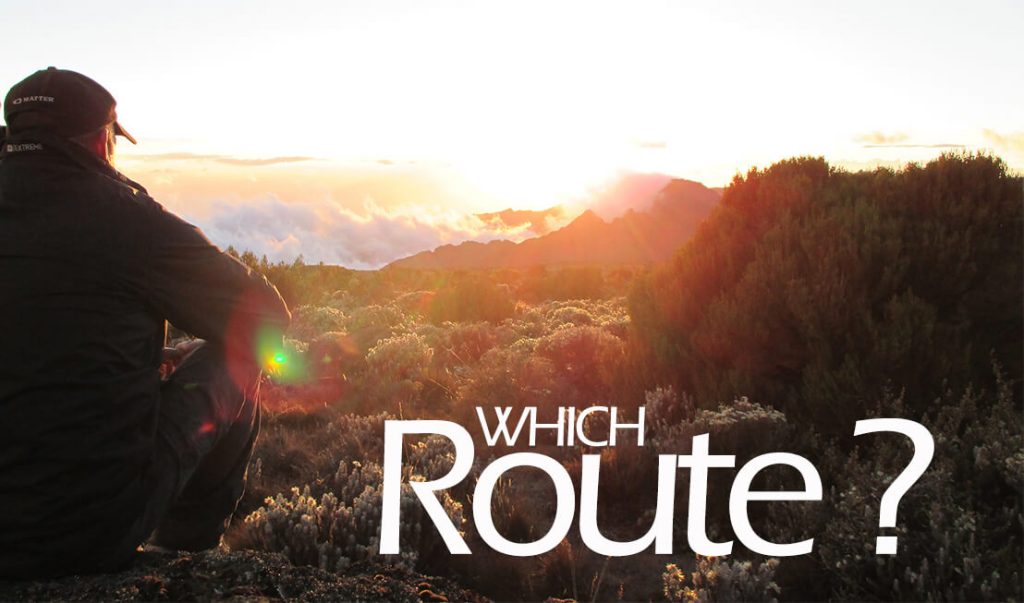

There are seven ways of getting to the summit of Kilimanjaro, but which of the routes up the mountain is best for you?
When hiking up Kilimanjaro you have the option of starting your ascent up seven different routes. All Kilimanjaro routes vary in the number of days you spend on the mountain and where you start and finish your climb. The main routes can be grouped according to the direction of approach and point of ascending to the crater rim.
- From the South: Machame, Western Breach and Umbwe
- From the West: Lemosho, Shira and Northern Circuit
- From the East: Marangu
- From the North: Rongai
At around 4000m, these paths all intersect with a circular path known variously as the Southern or Northern Circuit Path, depending on which side of the mountain you are on. You are then faced with three ascent paths to the summit – the Normal/Marangu Route, Barafu Route and Western Breach Route.
Each of these routes varies in terms of length, difficulty, what you will see along the way and, of course, cost. Regardless, each one will reward you with stunning panoramas and an incredible variety of scenic wonders. Read on to discover the best route for you to summit Kilimanjaro.
Acclimatisation is key
Acclimatization is the difference between making it to the summit or not. If you are fit enough to attempt Kilimanjaro at all, then acclimatization is the main barrier between success and failure.
It therefore makes sense to choose a route which gives you the best opportunity to acclimatize properly before your final push to the Summit.
Although there are 7 official routes to climb Kilimanjaro, we urge our climbers to opt for one of the following which allows for an extra day on the mountain for acclimatisation.
- Lemosho 8 Day Trek
- Machame 7 Day Trek
- Rongai 7 Day Trek
In our opinion, the optimal way to climb Kilimanjaro is to spend 8 days climbing, acclimatizing, learning how to walk and breath properly. After all, your goal is to climb Kilimanjaro, stand on the roof of Africa and enjoy the whole experience – which is why our first choice is an 8 Day trek via the Lemosho Route.
6. How fit do I need to be?
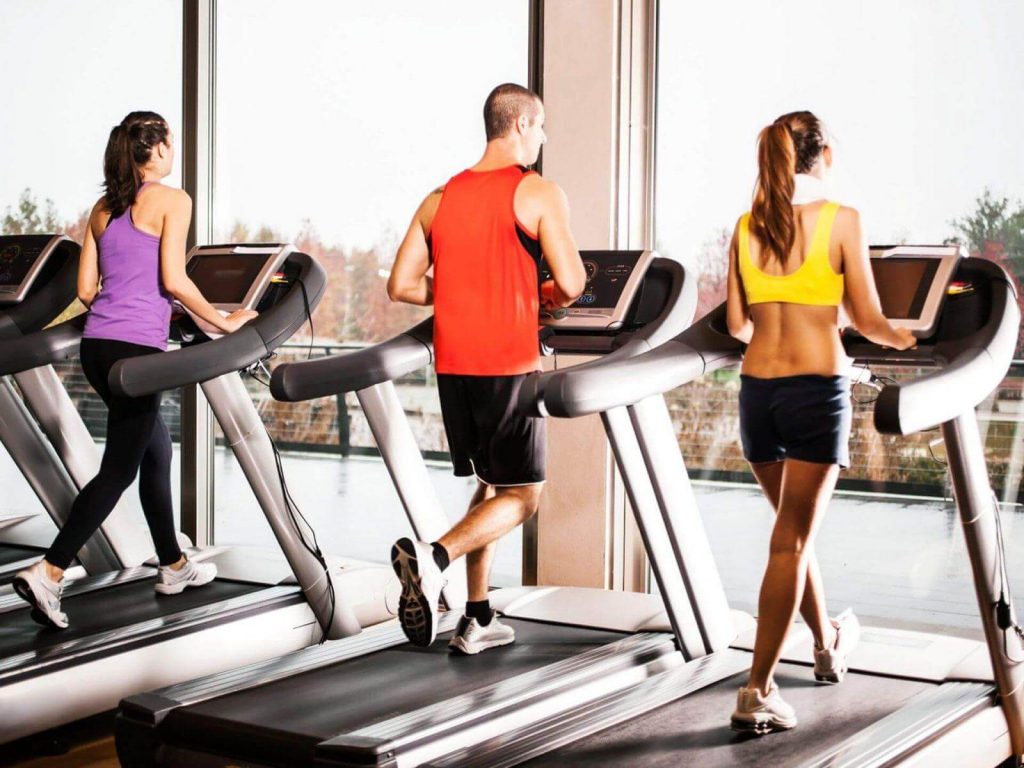

If you are new to an exercise routine, it can be a good idea to have a consultation with an experienced personal trainer. A trainer can assess your current fitness levels and any structural imbalances that need to be addressed.
For any long-distance, multi-day hike at altitude you will need:
- Endurance: the days are long, and the altitude will make you feel more out of breath than normal. Your cardiovascular fitness needs to be good.
- Strength: your legs are carrying yourself and your daypack. Uphill. And on the final day (Kilimanjaro), relentlessly uphill. It’s got more in common with weighted walking lunges than a stroll to the shops.
- Mental Stamina: particularly for the summit of Kilimanjaro. No matter how fit you are, you will need mental endurance to get you to the top.
Anyone in good health, with no medical contra-indications can attempt Kilimanjaro.
Just being “super fit” won’t get you to the summit. Most people who fail, do so because of the altitude.
But if you are unfit and in poor physical condition it will be more difficult and you will be more at risk of injury.
It’s all about preparation and with our very own personal Kilimanjaro trekking trainer, Amy, we can help you develop a training plan to suit your needs. READ MORE HERE
7. What gear and clothing do I need?


Having the correct clothing & personal equipment will make your Kilimanjaro climb more enjoyable and comfortable and ultimately increase your chance of a successful summit. We are fully aware that with all the different information and Kilimanjaro equipment lists out there, acquiring the correct gear can become very confusing and frustrating.
To help you through this aspect of your planning, we would advise you read through our Kilimanjaro Equipment guide. It is based on our first hand experience and will walk you through the essentials and “good to have`s” for your trek.


8. Do I need insurance?
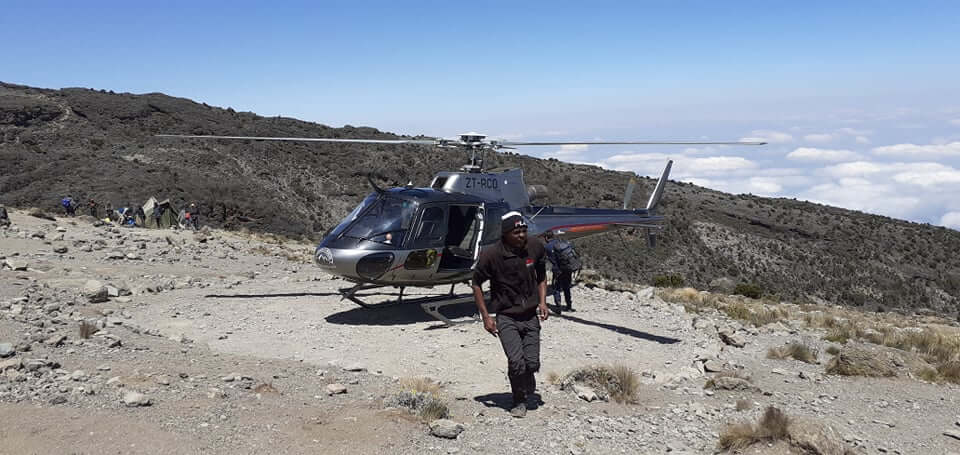

Some of the key inclusions you will require in your Kilimanjaro travel insurance policy are the following:
- Make sure your policy covers you for the altitude you will be visiting (6000m)
- The policy should cover you for evacuation by helicopter in case of emergency
- There should be adequate medical cover and cover for loss of equipment
We highly recommend WORLD NOMADS. The company has a background in trekking and they offer very good cover at a reasonable price.
Travel Insurance. Simple & Flexible.
Which countries or regions are you travelling to?
What’s your country of permanent residence?
What is your province?
Start date
End date
Who’s going?
Who’s going?
Helicopter Evacuation
9. Do I need any vaccinations?
Part of planning your trek should involve doing some research in to what the recommended vaccinations for Kilimanjaro are and consulting your doctor for a health check.
You’re safe from malaria on Kilimanjaro as it is too cold and high for mosquitoes. The disease is rife through lower elevations in Tanzania though so you should take standard precautions to ensure you are not affected – consult a travel health specialist for advice. Other inoculations you might want to consider include diphtheria, tetanus, typhoid, hepatitis and polio.
Yellow Fever
If you are arriving directly in Tanzania it is not necessary. However, if you are arriving through a country that is subject to yellow fever you will need to be vaccinated. Stop overs where you do not leave the airport in a country affected should not require the vaccination.
10. What is the food like on the mountain?
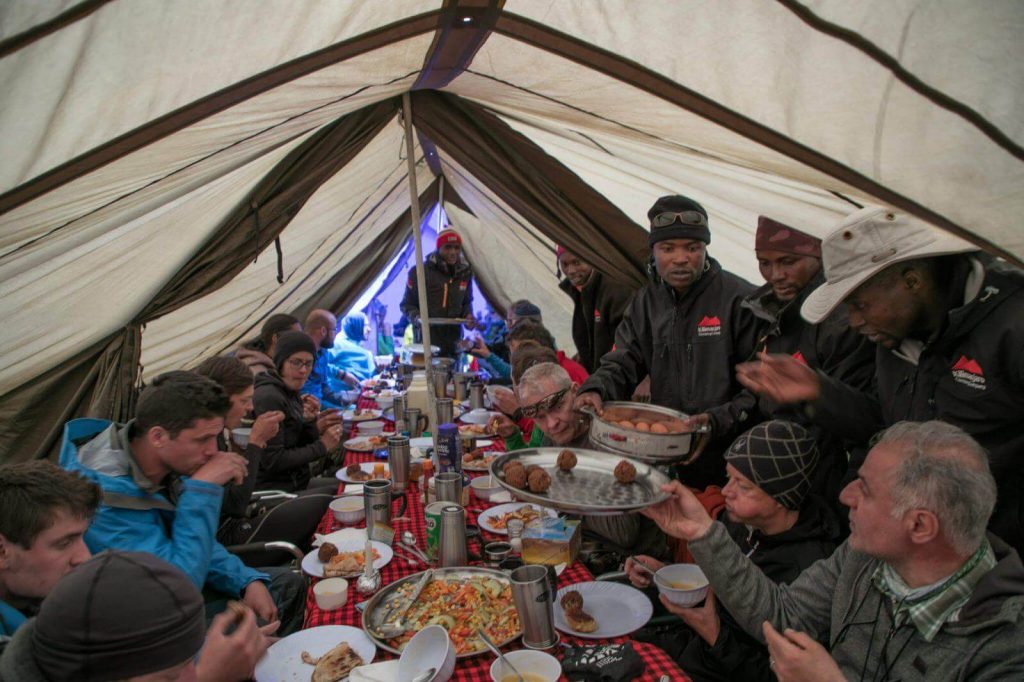

Good food and plenty of drinking water are essential ingredients, both physically and psychologically, to make your climb rewarding. At high altitudes, drinking a lot of water is essential for your health and helps preventing altitude sicknesses. It goes without saying that your body will also need plenty of food to compensate for the unusual physical effort in climbing.
Our cooks have been professionally trained and are able to conjure up tasty and nutritious food. Both meat and nuts form a substantial part of the food on Kilimanjaro. However, we can cater for any dietary restrictions so that vegans, vegetarians, gluten and lactose intolerants and those with restrictions due to their religious beliefs are all accommodated. Just make sure you let us know in advance of any dietary restrictions you may have. READ MORE HERE
What can we learn from the Hadzabe Tribe?
Meeting the Hadzabe Tribe...... Trekking with KCC is not just about Kilimanjaro. Many of our trekkers go on to do
Tanzania Entry Requirements in response to Covid-19
Hooray! We are back on the mountain and the treks are starting to fill up ! But what are the
Kilimanjaro COVID-19 Update
Kilimanjaro COVID-19 Update President John Magufuli said on Sunday that he was looking to encourage foreign tourists, business visitors to
Kilimanjaro Coronavirus COVID-19 Update 23.03.2020
Kilimanjaro Coronavirus Update - 23.03.2020 Over the weekend the Government of Tanzania instituted additional travel measures to limit the spread
Kilimanjaro and the Coronavirus – Covid-19
The outbreak of the coronavirus COVID-19 has caused uncertainty amongst the public. Many tourists are unsure about travelling in general.
Learn some Swahili before you go
So, you’ve been training for your big adventure to Kilimanjaro – but have you thought about learning a bit of
Choosing the right Kilimanjaro Route
Choosing the right Kilimanjaro route There are seven ways of getting to the summit of Kilimanjaro, but which of the
Personal training for Kilimanjaro
Training style to suit your needs Although there are general guidelines, in reality, there is no "one size fits all"
What should I wear on Summit Night?
Summit Night - From Head to Toe This is when you’re ‘likely’ to want all your main layers, but do




